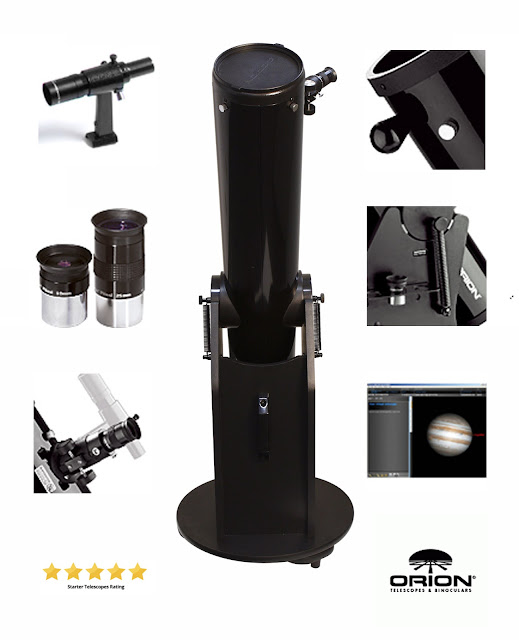The Orion SkyQuest XT4.5 Dobsonian allows beginners with a curiosity for the night sky to explore space on a moments notice. Stargazing is eazy and enjoyable for the whole family thanks to the Dobsonian design. This reflector telescope is extremely portable, so stargazing will become a regular outdoor activity at home or the cottage.
Orion SkyQuest XT4.5 Dobsonian Review
The innovative design of this telescope make it a "point-and view" instrument, perfect for wandering around the stars. This user-friendly design is a great way to find Messier objects and learn the location of many deep-sky objects on your own. Use the included 6 x 26 correct-image finder scope to locate objects in space, and then peer through the included eyepieces for a deeper look.
Two fully coated 1.25" Sirius Plossl eyepieces are included with the telescope:
- 25mm for wide views at 36X magnification
- 10mm for close up views at 91X power
Intermediate telescope users will find the high quality construction and handy accessories are welcome change from the old department store telescopes of years passed. The handy navigation knob, CorrecTension spring system, and rack-and-pinion focuser are built to last through a lifetime of night sky observations.
Add more eyepieces to your astronomy gear over time. The SkyQuest XT4.5 Dobsonian accepts all 1.25" telescope eyepieces.
 |
| Everything that comes with the Orion SkyQuest XT4.5 Telescope |
View Galaxies and Nebulae
The Orion SkyQuest XT4.5 Classic Dobsonian's tube assembly features a 4.5" mirror with enough light-gathering power to put on a real show. This 114mm spherical primary mirror soaks in over 200% more starlight than the lens of a 60mm refractor.
This light gathering ability means that you can see more celestial objects in the night sky, and in greater detail! This means views of nebulae and galaxies are possible with the Orion Skyquest XT4.5. You will never forget your first look at the Andromeda galaxy, I promse you that!
View the Moon and Planets up Close
This telescope is perfect for surveying the Moon's craters and valleys. Watch the different lunar features present themselves through each phase night after night. The SkyQuest also excels at well-defined views of the planets in our solar system including the cloud bands of Jupiter, and it's nnearby Galilean moons.
If you really want to impress the neaighbours, move the scope towards the dazzling planet Saturn. One look at Saturn's rings through the Orion SkyQuest4.5XT will change the way you look at our planet! Experience the humbling feeling of the realization of how small and fragile our planet really is.
 |
| Saturn captured by One Minute Astronomer |
Classic Dobsonian Reflector Design
The design of the Orion SkyQuest XT4.5 Classic Dobsonian telescope was built with ease-of-use in mind. The Dobsonian reflector design is extremely popular in all sizes, for good reason. It is arguably the most user friendly style of telescope, thanks to it's versatility. Moving the telescope up and down, and side to side is comfortable and easy. Young children and older observers will have no trouble with this telescope.
Why are Dobsonian Telescopes a Favorite Amatuer Astronomers
You do not have to worry about lock knobs or adjusting the telescope balance at all. The sturdy base provided with the Orion SkyQuest handles the weight of the reflector optical tube and finderscope. The base includes Nylon bearing pads to make sure that the telescope glides smoothly during use. The base itself is extremely stable, much more so than a traditional tripod.
 |
| The Orion SkyQuest XT4.5 Dobsonian sitting on a table from AstroBackyard |
The best part about the SkyQuest XT4.5 Classic Dobsonian model is that it is the smallest version in the series, which makes it easy to carry and travel with. You'll never go camping without it!
View the SkyQuest XT8 Classic Dobsonian
What's Included with the Telescope?
- 25mm Sirus Plossl Eyepiece
- 10mm Sirius Plossl Eyepiece
- 6 x 26 correct-image finder scope
- 1.25" rack and pinion focuser
- collimation cap
- eyepiece rack
- Starry Night software
Orion SkyQuest XT4.5 Classic Dobsonian Specs:
Optical Diameter: 114mm
Focal Length: 900mm
Focal Ratio: f/7.97
Optical Design: Reflector
Weight: 17.6 lbs
Final Thoughts
The Orion Skyquest XT4.5 Classic Dobsonian telescope is a very capable telescope for beginners and intermediates alike. Amateur astronomers agree that this is one of the best possible "first telescopes" one can own. With a large 114mm reflector mirror capable of providing views of the solar system and deep-sky objects, the Orion SkyQuest will bring the "wow-factor" to any backyard.
The portable size and versatility of the XT4.5 make observing the night sky a hassle-free experience, which is important for beginners learning the night sky. This telescope provides an incredible value considering it's quality and included accesories.
This is the highest rated beginner telescope on Starter Telescopes.































